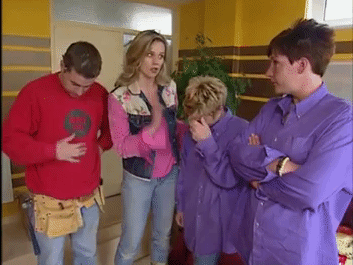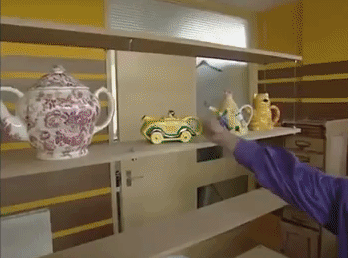The woman whose teapots were destroyed on Changing Rooms
In the latter half of the year 2000, strangers would apologise to Clodagh on the bus.
In the latter half of the year 2000, strangers would apologise to Clodagh on the bus. That June, the 55-year-old graphic designer had taken part in the home makeover show Changing Rooms. For two days, she was locked out of her flat as her neighbours and interior designer Linda Barker renovated the space. What happened next is not just British TV history, but British history itself. Linda Barker created a set of suspended shelves to house Clodagh’s prized teapot collection. As a finishing touch, she placed a number of hardback books on the unit. The shelves – and consequently the teapots – collapsed.
“It is known as the biggest disaster that Changing Rooms has ever had,” says Clodagh, who is now 75 and still living in the same flat where the catastrophe occurred. During her self-described “fifteen minutes of fame” after the show aired, strangers regularly offered their condolences.
Yet Clodagh’s fame has now lasted decades longer than those initial fifteen minutes. Sixteen years after the show’s final episode, Changing Rooms endures in our collective memory because of the bizarre and baffling decisions made by the show’s designers. Linda Barker herself has jokingly apologised for the crew’s actions, which include creating MDF Roman statue bedposts and surrounding a fur bed with nails. But if you Google “Changing Rooms” today, Clodagh’s smashed teapots are the first picture result on the right-hand side bar, and clips of the disaster still go viral on social media. As the full episode is unavailable online, little is known of how Clodagh felt at the time – let alone how she feels twenty years on.
Illustration by Karolinka Designs
Clodagh never applied to take part in Changing Rooms. The show’s producers wanted to feature a council flat and approached local authorities for recommendations – as Clodagh was an active member of various resident committees, she was put forward as a potential participant. “It was interesting,” she says of the filming process. She and her teenage daughter Julia decorated a neighbour’s flat and – with the help of TV personality Laurence Llewelyn-Bowen – renovated the living room in a 1950s style to match the exterior of the tower block. But when it was time for Clodagh and Julia to return to their flat and film the “reveal” portion of the show, they were instead sent to a third flat, belonging to a stranger.
“We knew there was something happening,” Clodagh says, “I think Lawrence was able to get away from the scene.” Before taking part in the show, Clodagh had written “quite a careful letter” to producers asking for her “lifetime’s collection” of teapots to be housed in a corner cabinet. She believes now that the letter went missing, but nonetheless her neighbours knew the sentimental and monetary value of the teapots. They were wary when Linda Barker suggested shelves suspended from the ceiling by wires. “It’s my fault entirely, and I’m going to take responsibility for that,” Barker told the neighbours as they later wept around the shattered remains of Clodagh’s teapots.
After delivering the bad news to Clodagh, Barker expressed relief. “She was disappointed, but she was actually okay about it, and it kind of took my breath away,” the presenter said, “I was so relieved.” In fact, producers had told Clodagh and Julia the news before they met with Barker. “Julia was 15 and she was very upset and I didn’t want everybody to go just exploding all over the place because they were angry. My thought was the best thing to do would be very calm,” Clodagh explains. She managed to comfort her daughter. “She was very good about it. I mean, fundamentally this was her inheritance that Linda Barker’s just dropped.”
Clodagh’s teapots were worth just over £6,000 and many were extremely precious to her; one of her sets, by the designer Clarice Cliff, had originally been one of her mother’s 21st birthday presents. Because of her design background, Clodagh collected teapots because she found them “curious” – she purchased a pot when she wanted to study the artistic decisions behind its design.
After the disaster, Clodagh never started another teapot collection, although one or two friends gave her ceramics as gifts. “The teapots I’ve found and would’ve liked, I haven’t bothered to collect,” she says. “I couldn’t bear it to happen all over again.”
An insurance company reimbursed Clodagh with the value of the teapots, but two decades later, the wound is not completely healed. Describing the encounter with Barker, Clodagh says, the presenter “was very apologetic”, before adding, “I felt you can’t possibly be apologetic enough.” She notes that even if the shelves hadn’t collapsed, they were hanging just outside her kitchen door “in the most inappropriate place” that would’ve been impossible to live with.
“I still feel that she’s got what she deserved, which is really being dropped by everybody,” Clodagh says of Linda Barker. “I still don’t feel very good about her. On the very rare occasion she’s on television now, when I do see her, she’s still very bouncy, and I just don’t think she earned the bounce,” she laughs.
Nonetheless, Clodagh doesn’t regret appearing on the show – she believes it was beneficial for the residents of her block of flats and adds that, “Julia enjoyed working with Handy Andy”. When I tell Clodagh people still watch the incident, she notes, “It’s a pity they didn't have a camera rolling when the shelves gave way, that’s really the biggest pity.”
Shortly after appearing on the show, Clodagh redecorated her living room, rolling ivory paint over the brown and yellow striped walls designed by Barker and her neighbours. “There were silly things about it,” Clodagh says of the renovation. A wonky table had been made out of a garden trellis and Ikea legs (“If you put a food on it that had anything liquid, it just trickled straight down onto your knee”).
Clodagh believes that if one message should be taken away from the teapot disaster, it’s that we should respect one another’s property. “Whether you think it’s important or not, you don’t suspend it from six wires from a ceiling with 40 kilos of books on the bottom shelf.”
Before appearing on the show, Clodagh had the opportunity to buy a Barge Ware teapot in an antique shop in Windsor. “The one thing I really wanted was a massive Barge teapot… I could’ve got it for very little money at the time,” she says. In hindsight, she is glad she didn’t make the purchase. “I’m glad Linda Barker didn’t smash that,” she says.
If you enjoyed this story, please consider leaving me a tip at: www.paypal.me/AmeliaTait. The Waiting Room is a space for slightly sillier stories during the Covid-19 crisis. Via PayPal, I hope different people can donate at different times depending on whether a story resonated with them. Whether 10p or £10, I am grateful for your contribution!
♥ Logo by Karolinka Designs








